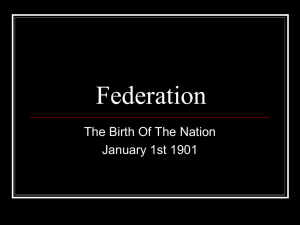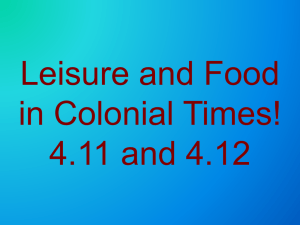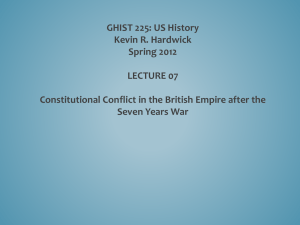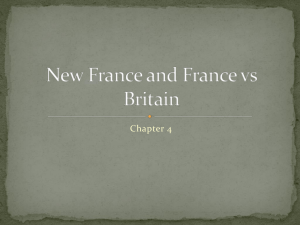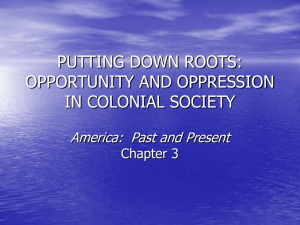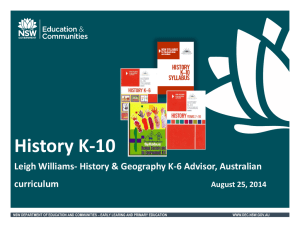Hopes and Fears of Federation
advertisement
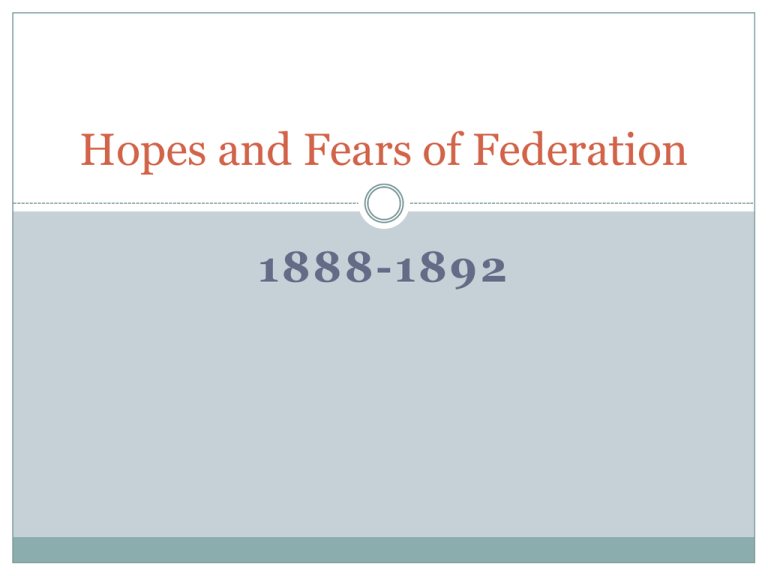
Hopes and Fears of Federation 1888-1892 Terms to Know Constitution: The document which sets out the relationship between the states (formerly colonies) and the federal government. It details which level of government has power in specific areas. Convention: A formal meeting where delegates, elected or otherwise, gathered to draft or modify the constitution bill. Billites: Those in favour of the constitution bill and hence federation. Anti-billites: Those opposed to the constitution and federation. Secede: To withdraw from federation or a colony. Please note colonies before federation and states after. Road to Federation 1883: A Federal Council was established where colonies could discuss common concerns. It did not have any power to pass laws and colonies decided individually to enact recommendations. Council was disbanded by 1899. Oct 1889, NSW Premier Henry Parkes made his famous Tenterfield speech which renewed the impetus for federation. Road to Federation In the speech he declares: “…surely what the Americans had done by war, Australians could bring about in peace. (Cheers). In relation to national defence: “…to preserve the security and integrity of these colonies that the whole of their forces should be amalgamated into one great federal army.” On railway transport: “…from South Australia to Queensland, a stretch of about 2000 miles of railway…to adopt a uniform gauge, it would be an immense advantage in the movement of troops.” Road to Federation: Defence 1889: British military expert Major General J.B. Edwards investigation into Australia’s military position military position concluded that only a federated force could adequately defend the continent. Historian Geoffrey Blainey: “The six colonies gloried in being separate. They ran their own post offices…built their own railways, and conducted their own immigration programmes…each colony controlled its own defence forces. South Australia had gunboats, New South Wales had torpedo boats and Tasmania had its volunteers…in 1889, the seven colonies of Australia and New Zealand could call on 30,000 volunteers in an emergency but barely 1000 servicemen. Road to Federation: Defence Defence was becoming an increasingly important issue: France moved into the New Hebrides in 1871 and Germany colonised the eastern portion of New Guinea in 1884. Russia was expressing colonial interest in the region while the British fleet was on the other-side of the globe and the empire was waning in power. Subsequently invasion and defence was becoming an issue that could be addressed with federation. ‘Defence Not Important?’ Ray Willis Historian Ray Willis argues that the issue of defence and invasion was only an issue for a minority of people in the colonies. According to Willis in his “Defence Not Important?’ he argues “…in the 1890s much was said about the lack of danger to Australia…[there was] also the period of relative calm in Europe and most of the world from 1889 to 1899.” AGL Shaw agreed: “…while the British navy was supreme there seemed little danger of foreign aggression in the remote Pacific. Admittedly there had been some little stir…[but] confined to a small group of the population. ‘Defence Not Important?’ Conversely Manning Clark states: “Defence, fears of coloured labour, and economic interest strengthened the motives for union over the last twenty years of the century….Indeed every war scare in the Pacific…led to talk about federation” Blainey supports this assertion: “By the early 1880s they [Australian colonialists] were not sure whether they should rely so much on Britain…Many Australians rightly feared that Germany would annex part of New Guinea and nearby islands and that France would annex the New Hebrides…the Australian colonies agreed to defray [pay] part of the cost of the British naval squadron…based in Sydney.” Tariffs A tariff is a charge or tax placed on goods when they enter a border. Each colony had a tariff charges at their borders. Two-fold effect: raised on funds for the colonies and protected local industries as the imported goods were more expensive. Mirams: “The collection of duties caused much irritation as well as hindering commerce.” These tariffs were directly related to the intense rivalry and jealously between the colonies especially NSW and Victoria. NSW vs Victoria Further these two states had diametrically opposed economic philosophies – NSW advocated free trade while Victoria was protectionist. Free Trade: removal of laws and rules that hamper the free movement of goods being bought and sold across borders. Protectionist: introduction of laws and rules that protect local businesses from outside competition. NSW was fearful that Victoria would use its economic dominance to create a protectionist federation. Free Trade vs Protection Victoria had a policy of high duties (taxes/tariffs) to protect industries from overseas competition. NSW had a policy of low duties to encourage trade and low-cost of goods. Many of NSW’s leading industries were built on overseas trade. These two colonies could not agree about laws on imports if there were to be federation. Most other colonies had protectionist policies therefore NSW was concerned about the future economic direction of federation. It was finally resolved by choosing to deal with this issue after Australian Federation was formed. Immigration Immigration was the one issue that all colonies agreed. Even though historians like Willis downplay it as a causal factor, it did create a bond, a unity amongst colonies. Clark: “Between 1880 and 1900 the fear of coloured labour degenerated into hysteria in the eastern colonies…[they] feared a lowering of their living standards from competition between white and coloured labour.” Immigration Blainey agrees quoting Alfred Deakin who identifies the Japanese as having “inexhaustible energy” and “their endurance and low standard of living that make them such competitors.” Shaw: “…all colonies were unanimous; all had passed similar legislation to preserve the purity of White Australia…” Subsequently many historians argue that each colony had their own means of legislation to deal with maintaining a White Australia however Ann Curthoys counters that there was a fear that the effectiveness of these laws were questionable. Chinese Immigration 1888 a shipload of Chinese are turned away from a Melbourne port told they could not land. When the ship sailed to Sydney the largest popular demonstration of its time arrived at the port to stop the human cargo from arriving on their shores. Alfred Deakin and the Bulletin were vocal advocates of blocking increased Asian immigration. The Mongolian Octopus The Bulletin published an infamous cartoon entitled, ‘The Mongolian Octopus’ The image is of an octopus with a male Chinese head. The face is purposely depicted in an unattractive and aggressive manner. The tentacles are quite literally strangling everything that Australians hold dear with each tentacle representing the evils of Chinese immigration (cheap labour, immorality, opium, small pox, etc.). The Mongolian Octopus Melbourne Conference Following Parkes Tenterfield speech a conference was called to discuss the forming of federation. It was held in Melbourne in Feb 1890. Involved six colonial premiers and two representatives from New Zealand as a potential seventh colony. At the meeting the delegates sought to move towards an independent union not a republican as they desired to remain loyal to the United Kingdom (Hirst). After the success of the Melbourne Conference they agreed to meet again. Sydney Convention 1891 Sought to draft a constitution that would have to be approved by the colonial parliaments (which still included New Zealand). Premier of Qld Samuel Griffith was seen as the chief architect of the document. NSW parliamentarian Edmund Barton and SA premier Charles Kingston also played a significant role in the drafting. Could not agree to introduce a Bill of Rights like the American model. Failure of the Sydney Convention The document failed to gain any popular support. Historian Helen Irving: “The Bulletin was quick to denounce it and New Zealand decided to withdraw”. AGL Shaw: “Rarely has there been a greater flop. In New South Wales it was violently attacked as unjust and likely to jeopardize her free-trade policy…The other colonies did nothing or discussed the scheme in a desultory fashion…The whole project seemed to be stillborn.” Factors halting Federation Two unforseen factors temporarily halted the federation train and even prompted Henry Parkes to withdraw his support. An economic depression in the 1890s resulted in the loss of jobs and the associated loss of confidence by industry. Subsequently battles between workers and bosses on the waterfront and the pastoral industry ensued. Furthermore the King Drought of 1895 caused huge problems for both the pastoral and agricultural industries. Men of Federation: Henry Parkes Henry Parkes was the premier of NSW and a vocal advocate of federation. However he did not play an active role in the drafting of the constitution or in working with the other delegates. He was largely seen as a figurehead/ the public face of federation. However his leadership in the formation of federation was questionable as he had dropped the proposed constitution in the early 1890s which led to other colonies to follow suit. Some historians have argued that he was in favour of federation purely as a means to secure his place in history. Men of Federation: Samuel Griffith Men of Federation: Edmund Barton Men of Federation: Charles Kingston Men of Federation: Andrew Inglis Clark
